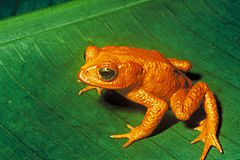Toad facts for kids
Quick facts for kids Toads |
|
|---|---|
 |
|
| Golden Toad, Bufo periglenes | |
| Scientific classification | |
| Kingdom: | |
| Phylum: | |
| Class: | |
| Order: | |
A toad is a fascinating type of amphibian, which means it's an animal that can live both on land and in water. Toads are often confused with frogs because they look similar and belong to the same large group of animals. It's true that all toads are a kind of frog, but not all frogs are toads!
Toads have mostly grown to live in drier places. Because of this, many toads have rougher, bumpy, and often browner skin that helps them blend in with their surroundings. Many also dig burrows to stay cool and moist, though this depends on where they live. Toads lay their eggs in long strings that often stick to rocks or plants in the water. This is different from "true" frogs, which usually lay their eggs in a big, jelly-like clump. Toads also tend to have shorter legs and rounder bodies than most frogs. Behind their eyes, toads have special bumps called paratoid glands. These glands can release a mild poison that helps protect them from predators. Don't worry, this poison is usually not harmful to humans!
Contents
What Makes a Toad Special?
Toads are amazing creatures with unique features that help them survive. As amphibians, they start their lives in water as tadpoles, breathing with gills. As they grow, they change into adults that can live on land and breathe with lungs and through their skin.
How Toads Are Different from Frogs
Even though all toads are frogs, there are some easy ways to tell them apart:
- Skin: Toads usually have dry, warty, and bumpy skin. Frogs often have smooth, moist, and slimy skin.
- Body Shape: Toads tend to have wider, flatter bodies and shorter legs. This makes them better at walking or hopping short distances. Frogs usually have slimmer bodies and long, powerful legs for jumping and swimming.
- Eggs: Toads lay their eggs in long chains, like a string of beads. Frogs lay their eggs in big, jelly-like masses or clumps.
- Glands: Toads have those special paratoid glands behind their eyes that produce a mild toxin. Most frogs don't have these specific glands.
Where Do Toads Live?
Toads are found all over the world, except in very cold places like Antarctica. They are very good at adapting to different environments. While many prefer drier areas like deserts or grasslands, you can also find them in forests, gardens, and even near ponds or slow-moving streams. They often hide under rocks, logs, or in burrows they dig themselves to stay safe and moist.
What Do Toads Eat?
Toads are carnivores, which means they eat other animals. They are great at catching insects like flies, beetles, and crickets. They also enjoy eating worms, slugs, and spiders. Toads usually hunt at night, using their long, sticky tongues to snatch up their prey.
How Toads Protect Themselves
Toads have several ways to stay safe from predators. Their bumpy, camouflaged skin helps them blend in with their surroundings, making it hard for animals to spot them. When threatened, they might puff up their bodies to look bigger and more intimidating. The mild poison from their paratoid glands is another defense. If a predator tries to eat a toad, the bad taste or mild irritation from the poison might make the predator drop the toad and look for an easier meal.
Life Cycle and Reproduction
The life cycle of a toad is a wonderful example of metamorphosis.
- Eggs: Female toads lay thousands of tiny eggs, usually in long strings, in water.
- Tadpoles: The eggs hatch into small, fish-like larvae called tadpoles. Tadpoles live in the water, breathing with gills and feeding on algae.
- Metamorphosis: Over several weeks or months, the tadpoles begin to change. They grow legs, their tails shrink, and their gills are replaced by lungs.
- Adult Toads: Once they have fully transformed, young toads leave the water and begin their lives on land. They will continue to grow until they reach their adult size and can then reproduce themselves.

